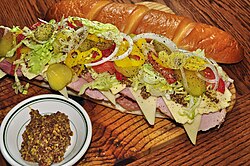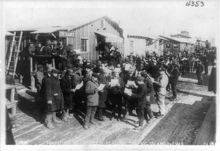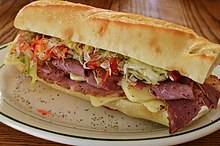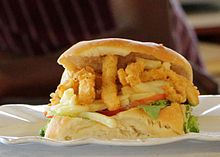food.wikisort.org - Dish
A submarine sandwich, commonly known as a sub, hoagie (Philadelphia metropolitan area and Western Pennsylvania English), hero (New York City English), Italian (Maine English), grinder (New England English), wedge (Westchester, NY), or a spuckie (Boston English), is a type of American cold or hot sandwich made from a cylindrical bread roll split lengthwise and filled with meats, cheeses, vegetables, and condiments.[2][3] It has many different names.[1][2]
 A submarine sandwich | |
| Alternative names | List
|
|---|---|
| Place of origin | United States |
| Region or state | Northeast |
| Main ingredients | Multiple |
| Variations | Multiple |
The terms submarine and sub are widespread in the US and not assignable to any certain part, though many of the localized terms are clustered in the northeastern United States.
History and etymology
The Italian sandwich originated in several different Italian American communities in the Northeastern United States from the late 19th to mid-20th centuries.[4] The popularity of this Italian-American cuisine has grown from its origins in Connecticut, Pennsylvania, Delaware, Maryland, New York, New Jersey, Massachusetts, and Rhode Island to most parts of the United States and Canada, and with the advent of chain restaurants, is now available in many parts of the world.[5][6][7] Edwin Eames and Howard Robboy identified thirteen different terms for the submarine sandwich in the United States.[8]
Submarine
The use of the term "submarine" or "sub" (after the resemblance of the roll to the shape of a submarine) is widespread in the United States and Canada.[2] While some accounts source the name as originating in New London, Connecticut (site of the United States Navy's primary submarine base) during World War II, written advertisements from 1940 in Wilmington, Delaware, indicate the term originated prior to the United States's entry into World War II.[9]

One theory says the submarine was brought to the U.S. by Dominic Conti (1874–1954), an Italian immigrant who came to New York in the late 19th century.[4] He is said to have named it after seeing the recovered 1901 submarine called Fenian Ram in the Paterson Museum of New Jersey in 1928. His granddaughter has stated the following:
My grandfather came to this country circa 1895 from Montella, Italy. Around 1910, he started his grocery store, called Dominic Conti's Grocery Store, on Mill Street in Paterson, New Jersey where he was selling the traditional Italian sandwiches. His sandwiches were made from a recipe he brought with him from Italy, which consisted of a long crust roll, filled with cold cuts, topped with lettuce, tomatoes, peppers, onions, oil, vinegar, Italian herbs and spices, salt, and pepper. The sandwich started with a layer of cheese and ended with a layer of cheese (this was so the bread wouldn't get soggy).[4]
Party sub
Party sub is the name for a particularly long submarine sandwich, usually cut into pieces and served to guests at parties. The longest on record measured 735 meters (2,411 feet, 5 in).[10]
Hoagie


The term hoagie originated in the Philadelphia area. In 1953, the Philadelphia Bulletin reported that Italians working at the World War I-era shipyard known as Hog Island, where emergency shipping was produced for the war effort, introduced the sandwich by putting various meats, cheeses, and lettuce between two slices of bread.[11] This became known as the "Hog Island" sandwich; shortened to "Hoggies", then the "hoagie".[12]
Dictionary.com offers the following origin of the term hoagie - n. American English (originally Philadelphia) word for "hero, large sandwich made from a long, split roll"; originally hoggie (c. 1936), traditionally said to be named for Big Band songwriter Hoagland Howard "Hoagy" Carmichael (1899–1981), but the use of the word predates his celebrity and the original spelling seems to suggest another source (perhaps "hog"). Modern spelling is c. 1945, and may have been altered by influence of Carmichael's nickname.[13]
The Philadelphia Almanac and Citizen's Manual offers a different explanation, that the sandwich was created by early-twentieth-century street vendors called "hokey-pokey men", who sold antipasto salad, meats, cookies and buns with a cut in them. When Gilbert and Sullivan's operetta H.M.S. Pinafore opened in Philadelphia in 1879, bakeries produced a long loaf called the pinafore. Entrepreneurial "hokey-pokey men" sliced the loaf in half, stuffed it with antipasto salad, and sold the world's first "hoagie".[14]
Another explanation is that the word hoagie arose in the late 19th to early 20th centuries, among the Italian community in South Philadelphia, when "on the hoke" meant that someone was destitute. Deli owners would give away scraps of cheeses and meats in an Italian bread-roll known as a "hokie", but the Italian immigrants pronounced it "hoagie".[1]
Shortly after World War II, there were numerous varieties of the term in use throughout Philadelphia. By the 1940s, the spelling "hoagie" had come to dominate less-used variations like "hoogie" and "hoggie". It is never spelled hoagy.[15] By 1955, restaurants throughout the area were using the term hoagie. Listings in Pittsburgh show hoagies arriving in 1961 and becoming widespread in that city by 1966.[15]
Former Philadelphia mayor (and later Pennsylvania governor) Ed Rendell declared the hoagie the "Official Sandwich of Philadelphia".[16] However, there are claims that the hoagie was actually a product of nearby Chester.[17] DiCostanza's in Boothwyn claims that the mother of DiConstanza's owner originated the hoagie in 1925 in Chester. DiCostanza relates the story that a customer came into the family deli and through an exchange matching the customer's requests and the deli's offerings, the hoagie was created.[18][19]
Woolworth's to-go sandwich was called a hoagie in all U.S. stores.[20]
Bánh mì sandwiches are sometimes referred to as "Vietnamese hoagies" in Philadelphia.[21]
Hero

The New York term hero is first attested in 1937.[22] The name is sometimes credited to the New York Herald Tribune food writer Clementine Paddleford in the 1930s, but there is no good evidence for this. It is also sometimes claimed that it is related to the gyro, but this is unlikely as the gyro was unknown in the United States until the 1960s.[5]
Hero (plural usually heros, not heroes[23]) remains the prevailing New York City term for most sandwiches on an oblong roll with a generally Italian flavor, in addition to the original described above. Pizzeria menus often include eggplant parmigiana, chicken parmigiana, and meatball heros, each served with sauce.
Grinder

A common term in New England is grinder, but its origin has several possibilities.[24] One theory has the name coming from Italian-American slang for a dock worker, among whom the sandwich was popular.[5] Others say that it was called a grinder because the bread's hard crust required much chewing.[25]
In Pennsylvania, New York, and parts of New England, the term grinder usually refers to a hot submarine sandwich (meatball, sausage, etc.), whereas a cold sandwich (e.g., cold cuts) is usually called a "sub".[9] In the Philadelphia area, the term grinder is also applied to any hoagie that is toasted in the oven after assembly, whether or not it is made with traditionally hot ingredients.
Italian
The term "Italian sandwich" or simply "Italian" is used in Maine. Local folklore claims that a baker named Giovanni Amato invented the Italian in 1899.[26]

The traditional Maine Italian sandwich is prepared using a long, soft bread roll or bun with meats such as salami, mortadella, capocollo or ham along with provolone, tomato, onion, green bell pepper, Greek olives, pickles, olive oil or salad oil, salt and cracked black pepper.[27][28][29] Additional ingredients, such as pepperoni, banana pepper, or lettuce may be added to the sandwich. The sandwich is often cut in half to make it easier to handle.[27][30][31]
Wedge
The term wedge is used in the New York counties of Dutchess, Putnam, and Westchester, as well as the Connecticut county of Fairfield – four counties directly north of New York City.
Some base the name wedge on a diagonal cut in the middle of the sandwich, creating two halves or "wedges", or a "wedge" cut out of the top half of the bread with the fillings "wedged" in between, or a sandwich that is served between two "wedges" of bread. It has also been said wedge is just short for "sandwich", with the name having originated from an Italian deli owner located in Yonkers, who got tired of saying the whole word.[32][9]
Spukie
The term spukie ("spukkie" or "spuckie") is unique to the city of Boston and derives from the Italian word spuccadella, meaning "long roll". The word spuccadella is not typically found in Italian dictionaries, which may suggest that it could be a regional Italian dialect, or possibly a Boston Italian-American innovation. Spukie is typically heard in parts of Dorchester and South Boston. Some bakeries in Boston's North End neighborhood have homemade spuccadellas for sale.[33]
Other names

- Blimpie (shaped like a blimp) – from the Hoboken, New Jersey–founded chain, Blimpie
- Gatsby – Cape Town, South Africa
- Po' boy – Louisiana
- Cosmo – Williamsport, Pennsylvania [citation needed]
- Zeppelin or Zep – eastern Pennsylvania[5]
- Smoske – Belgium
- Dagobert – Belgium
- Continental roll ('Conti roll') - Western Australia[34][35]
Popularity and availability
Rolls filled with condiments have been common in several European countries for more than a century, notably in France and Scotland.
In the United States, from its origins with the Italian-American labor force in the northeast, the sub began to show up on menus of local pizzerias. As time went on and popularity grew, small restaurants, called hoagie shops and sub shops, that specialized in the sandwich began to open.[5]
Pizzerias may have been among the first Italian-American eateries, but even at the turn of the [20th] century distinctions were clear-cut as to what constituted a true ristorante. To be merely a pizza-maker was to be at the bottom of the culinary and social scale; so many pizzeria owners began offering other dishes, including the hero sandwich (also, depending on the region of the United States, called a 'wedge,' a 'hoagie,' a 'sub,' or a 'grinder') made on an Italian loaf of bread with lots of salami, cheese, and peppers.
— John Mariani, America Eats Out, p. 66
Subs or their national equivalents were already popular in many European, Asian, and Australasian countries when late 20th-century franchisee chain restaurants (such as Subway) and fast food made them even more popular and increased the prevalence of the word sub. Many outlets offer non-traditional ingredient combinations.
In the United States, there are many chain restaurants that specialize in subs. Major international chains include Firehouse Subs, Quiznos, Mr. Sub, Jimmy John's, and the largest restaurant chain in the world, Subway.[36] The sandwich is also often available at supermarkets, local delis, and convenience stores. These include Wawa, which annually runs a sub promotional event during the summer called Hoagiefest,[37] and Publix, whose sandwiches are often referred to as "pub subs".[38][39]
See also
- Bánh mì
- Cuban sandwich
- Dagwood sandwich
- French dip
- List of American sandwiches
- List of regional dishes of the United States
- List of sandwiches
- List of submarine sandwich restaurants
- Muffuletta
- Panini
References
- Eames, Edwin; Robboy, Howard (December 1967). "The Submarine Sandwich, Lexical Variations in a Cultural Context". American Speech. 42 (4): 279–288. doi:10.2307/452990. JSTOR 452990. Accessed 15 January 2020 (subscription required).
- "submarine sandwich". The American Heritage Dictionary of the English Language (Fourth ed.). Houghton Mifflin Co. 2000. Retrieved August 22, 2013.
- "po'boy". Merriam-Webster Online Dictionary. Retrieved 20 March 2018.
- Stradley, Linda. "History of Hoagies, Submarine Sandwiches, Po' Boys Sandwiches, Dagwood Sandwiches, & Italian Sandwiches". Whatscookingamerica.net. Retrieved March 11, 2012.
- Wilton, Dave (Autumn 2003). "A Hoagie by Any Other Name" (PDF). Verbatim. XXVII (3). Retrieved November 21, 2008.
- "Ogden Finds a New Gastronomic Love in a Submarine Sandwich". Wilmington Sunday Morning Star. September 7, 1941.
- Popik, Barry (April 5, 2008). "The Big Apple: Submarine Sandwich". Retrieved August 22, 2013.
Delaware has the strongest claim to the 'submarine sandwich,' with that term appearing in a Wilmington telephone directory in January 1940.
- Eames, Edwin; Robboy, Howard (1967). "The Submarine Sandwich: Lexical Variations in a Cultural Context". American Speech. 42 (4): 279–288. doi:10.2307/452990. ISSN 0003-1283. JSTOR 452990.
- Peterson, Sam Dean, Erik S. (February 2013). "The Origin of Hoagies, Grinders, Subs, Heroes, and Spuckies". Bonappetit.com. Retrieved 23 December 2017.
- "Longest sandwich". guinnessworldrecords.com. Retrieved 24 September 2022.
- "Answer to Queries". Philadelphia Evening Bulletin. October 7, 1953. p. 59.
- "Philly Via Italy". www.34st.com. Retrieved 2022-06-28.
- "Definition of hoagie". Dictionary.com. Retrieved 2019-08-03.
- Finkel, Kenneth, ed. (1995). Philadelphia Almanac and Citizen's Manual. Philadelphia: The Library Company of Philadelphia. p. 86.
- Labov, William (2003). "Pursuing the Cascade Model". In Peter Trudgill; David Britain; Jenny Cheshire (eds.). Social Dialectology: In Honour of Peter Trudgill. John Benjamins Publishing Co. ISBN 978-1-58811-403-7.
- Philadelphia Visitors Bureau webpage Archived July 27, 2009, at the Wayback Machine
- Gebhart, Ed (February 9, 2003). "Hoagie, then known as Italian sandwich, got start in Chester". Delaware County Daily Times. Archived from the original on July 28, 2009.
- "1925: Hoagie Rolls into County History". Dicostanzas.com. Archived from the original on November 17, 2001. Retrieved December 9, 2009.
- Vigoda, Ralph (5 March 2003). "How the Hoagie Started: Truth, or a Lot of Baloney?". Philadelphia Inquirer. Archived from the original on 30 March 2012. Retrieved 21 May 2019.
- "Worcester, Mass - Places of the Past, Woolworth's". Worcestermass.com. Retrieved July 1, 2015."Hoagies". Woodenboat.com. Retrieved July 1, 2015."Best Hoagie in D'Burgh - Pennsylvania - Chowhound". Chowhound.chow.com. 2001-09-07. Retrieved July 1, 2015."Railroad Line Forums - 1957 Woolworth Menu". railroad-line.com. Retrieved February 2, 2016."Music Review: Neil Diamond: The Bang Years 1966-1968". Seattle Post-Intelligencer. 2011-03-18. Retrieved July 1, 2015."Many store memories of five-and-dimes". Tribunedigital-mcall. Retrieved July 1, 2015."Recipe Exchange: November 3, 2010". Tribunedigital-mcall. November 2, 2010. Retrieved July 1, 2015."Pleasant Family Shopping". pleasantfamilyshopping.blogspot.com. 2009-06-18. Retrieved July 1, 2015."Jasko v. F.W. Woolworth Co Case Brief". 4lawschool.com. Retrieved July 1, 2015."Woolworths - recall days of five-and-dimes - Recipes and more!". Tasteofhome.com. Archived from the original on July 31, 2013. Retrieved July 1, 2015.
- "Top 5 Banh Mi (Vietnamese Hoagies)". Philadelphia City Paper. July 20, 2006. Archived from the original on April 12, 2014. Retrieved July 1, 2015.
- Popik, Barry (June 11, 2004). "The Big Apple: Hero Sandwich". Retrieved August 22, 2013.
- "hero". Merriam-Webster.com. Retrieved 22 August 2013.
- Lebovitz, David (September 19, 2012). "Meatball Sandwich". Retrieved August 22, 2013.
- "Is There a Difference Between Hoagies, Heroes, Subs, and Grinders?". Thekitchen.com. Retrieved December 23, 2017.
- "Ode to the Amato's Maine Italian Sandwich". New England Today. 2021-01-12. Retrieved 2021-06-15.
- Stern, J.; Stern, M. (2007). Roadfood Sandwiches: Recipes and Lore from Our Favorite Shops Coast to Coast. Houghton Mifflin Harcourt. p. 186. ISBN 978-0-547-34635-9. Retrieved May 27, 2016.
- Smith, A.; Kraig, B. (2013). The Oxford Encyclopedia of Food and Drink in America (2d ed.). OUP USA. p. 351. ISBN 978-0-19-973496-2. Retrieved May 27, 2016.
- Thorne, J.; Thorne, M.L. (2008). Mouth Wide Open: A Cook and His Appetite. Farrar, Straus and Giroux. p. pt106–107. ISBN 978-1-4668-0646-7. Retrieved May 27, 2016.
- Gagne, T. (2011). New England Recipes. Kids Can Cook. Mitchell Lane Publishers, Incorporated. p. 18. ISBN 978-1-61228-161-2. Retrieved May 27, 2016.
- Korfhage, Matthew (May 24, 2016). "Your New Favorite Spicy Italian Sandwich Is at O-Bros Osteria Food Cart". Willamette Week. Retrieved May 27, 2016.
- Bonar, Julia (June 1, 2005). "The good times are on a roll with this New Orleans classic". The Boston Globe. Retrieved January 25, 2009.
- "Grinders, Subs, and Spuckies - Sandwich Names of New England - New England Today". Newengland.com. Retrieved December 23, 2017.
- "Origin of the continental roll - Australian food history timeline". 18 September 1950.
- "Continental Roll | Traditional Sandwich from Western Australia | TasteAtlas".
- Peterson, Kim (March 7, 2011). "Subway becomes world's largest restaurant chain". Money.msn.com. Archived from the original on June 23, 2013. Retrieved August 22, 2013.
- Cummings, Sinead (15 June 2017). "This is when Wawa Hoagiefest 2017 will begin". www.phillyvoice.com. Retrieved 2019-03-21.
- Waterfield, Sophia (17 February 2020). ""Pub subs" on sale this week: How to get discounted Publix sandwiches for $5.99". Newsweek. Retrieved 8 October 2020.
- "Southerners Know the Secret Behind the Publix Sub". Southern Living. 11 January 2018. Retrieved 8 October 2020.
External links
- Map of regional variation of the word for a submarine sandwich using data from Bert Vaux's online survey of English dialects (see question 64)
На других языках
- [en] Submarine sandwich
[ru] Сэндвич-субмарина
Сэндвич-субмарина (англ. submarine sandwich, сокр. саб, также hoagie, hero, grinder, Italian sandwich[1]) — бутерброд или сэндвич популярный в США, изготовленный из длинной булочки, разрезанной вдоль и наполненной мясными продуктами, сыром, овощами и приправами[2][3][4]. Имеет много разных названий[2][5]. Термины «субмарина» и «саб» наиболее распространены и не могут быть привязаны в какому-то конкретному региону страны, хотя многие из местных обозначений сэндвича сосредоточены в северо-восточной части Соединенных Штатов.Другой контент может иметь иную лицензию. Перед использованием материалов сайта WikiSort.org внимательно изучите правила лицензирования конкретных элементов наполнения сайта.
WikiSort.org - проект по пересортировке и дополнению контента Википедии